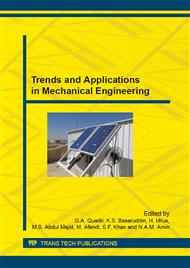[1]
X. Tan, Autonomous robotic fish as mobile sensor platforms: Challenges and potential solutions, Marine Technology Society Journal, vol. 45, pp.31-40, (2011).
DOI: 10.4031/mtsj.45.4.2
Google Scholar
[2]
F. Zhang, J. Thon, C. Thon, and X. Tan, Miniature underwater glider: Design, modeling, and experimental results, in Robotics and Automation (ICRA), 2012 IEEE International Conference on, 2012, pp.4904-4910.
DOI: 10.1109/icra.2012.6225264
Google Scholar
[3]
F. Zhang, J. Thon, C. Thon, and X. Tan, Miniature Underwater Glider: Design and Experimental Results, (2014).
DOI: 10.1109/icra.2012.6225264
Google Scholar
[4]
F. Zhang, F. Zhang, and X. Tan, Steady spiraling motion of gliding robotic fish, in Intelligent Robots and Systems (IROS), 2012 IEEE/RSJ International Conference on, 2012, pp.1754-1759.
DOI: 10.1109/iros.2012.6385860
Google Scholar
[5]
S. Zhang, J. Yu, A. Zhang, and F. Zhang, Spiraling motion of underwater gliders: Modeling, analysis, and experimental results, Ocean Engineering, vol. 60, pp.1-13, (2013).
DOI: 10.1016/j.oceaneng.2012.12.023
Google Scholar
[6]
N. E. Leonard and J. G. Graver, Model-based feedback control of autonomous underwater gliders, Oceanic Engineering, IEEE Journal of, vol. 26, pp.633-645, (2001).
DOI: 10.1109/48.972106
Google Scholar
[7]
J. G. Graver, Underwater gliders: Dynamics, control and design, Citeseer, (2005).
Google Scholar
[8]
J. Graver, J. Liu, C. Woolsey, and N. E. Leonard, Design and analysis of an underwater vehicle for controlled gliding, in Proc. 32nd Conference on Information Sciences and Systems, 1998, pp.801-806.
Google Scholar
[9]
D. T. Greenwood, Principles of dynamics: Prentice-Hall Englewood Cliffs, NJ, (1988).
Google Scholar
[10]
J. S. Geisbert, Hydrodynamic modeling for autonomous underwater vehicles using computational and semi-empirical methods, Virginia Polytechnic Institute and State University, (2007).
Google Scholar
[11]
F. I. Fluent 6. 1 User's Guide.
Google Scholar
[12]
P. Jagadeesh, K. Murali, and V. Idichandy, Experimental investigation of hydrodynamic force coefficients over AUV hull form, Ocean Engineering, vol. 36, pp.113-118, (2009).
DOI: 10.1016/j.oceaneng.2008.11.008
Google Scholar
[13]
A. Sohankar, C. Norberg, and L. Davidson, Low‐Reynolds‐number flow around a square cylinder at incidence: study of blockage, onset of vortex shedding and outlet boundary condition, International Journal for Numerical Methods in Fluids, vol. 26, pp.39-56, (1998).
DOI: 10.1002/(sici)1097-0363(19980115)26:1<39::aid-fld623>3.0.co;2-p
Google Scholar
[14]
M. F. bin Ibrahim, M. Ovinis, and K. bin Shehabuddeen, An Underwater Glider for Subsea Intervention: A Technical Feasibility Study, Applied Mechanics and Materials, vol. 393, pp.561-566, (2013).
DOI: 10.4028/www.scientific.net/amm.393.561
Google Scholar
[15]
M. Y. Javaid, M. Ovinis, T. Nagarajan, and F. B. Hashim, Underwater Gliders: A Review, in MATEC Web of Conferences, 2014, p.02020.
DOI: 10.1051/matecconf/20141302020
Google Scholar
[16]
M. Grund, L. Freitag, J. Preisig, and K. Ball, The PLUSNet underwater communications system: acoustic telemetry for undersea surveillance, in OCEANS 2006, 2006, pp.1-5.
DOI: 10.1109/oceans.2006.307036
Google Scholar
[17]
S. A. Jenkins, D. E. Humphreys, J. Sherman, J. Osse, C. Jones, N. Leonard, et al., Underwater glider system study, (2003).
Google Scholar


